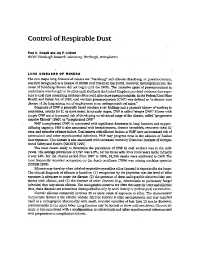Mining Publication: Control of Respirable Dust
Original creation date: February 2001
The two major lung diseases of miners are "blacklung" and silicosis. Blacklung, or pneumoconiosis, was first recognized as a disease of British coal miners in the 1600s. However, investigations into the cause of blacklung disease did not begin until the 1900s. The causative agent of pneumoconiosis in coal miners was thought to be silica until studies in the United Kingdom provided evidence that exposure to coal dust containing minimal silica could also cause pneumoconiosis. In the Federal Coal Mine Health and Safety Act of 1969, coal workers pneumoconiosis (CWP) was defined as "a chronic dust disease of the lung arising out of employment in an underground coal mine." Diagnosis of CWP is generally based on chest x-ray findings and a patient's history of working in coal mines, usually for 10 or more years. In its early stages, CWP is called "simple CWP." Miners with simple CWP are at increased risk of developing an advanced stage of the disease, called "progressive massive fibrosis" (PMF) or "complicated CWP." PMF (complicated CWP) is associated with significant decreases in lung function and oxygen diffusing capacity. PMF is also associated with breathlessness, chronic bronchitis, recurrent chest illness, and episodes of heart failure. Coal miners with silicotic lesions or PMF have an increased risk of tuberculosis and other mycobacterial infections. PMF may progress even in the absence of further dust exposure. This disease is also associated with increased mortality (National Institute of Occupational Safety and Health [NIOSH] 1995). The most recent study to determine the prevalence of CWP in coal workers was in the mid 1990s. The average prevalence of CWP was 2.80/0, but for those with 30 or more years in the industry it was 140/0. For the 10-year period from 1987 to 1996, 18,245 deaths were attributed to CWP. The most frequently recorded occupation on the death certificate (70%) was mining machine operator (NIOSH 1999). Silicosis may develop when inhaled respirable crystalline silica (quartz) is deposited in the lungs. The clinical diagnosis of silicosis is based on (1) recognition by the physician that the level of silica exposure is adequate to cause the disease, (2) the presence of chest radiographic abnormalities consistent with silicosis, and (3) the absence of other illnesses (e.g., tuberculosis or pulmonary fungal infection) that may mimic silicosis. The radiographic patterns are often the same for CWP and silicosis; thus, these diseases are sometimes distinguishable only by work history or pathological examination. Chronic silicosis commonly involves 15 or more years of exposure to silica. The characteristic microscopic feature is the silicotic nodule. Chronic silicosis is often asymptomatic and may manifest itself as a radiographic abnormality with small, rounded opacities of less than 10 mm in diameter, predominantly in the upper lobes. Lung function may be normal or show mild restriction. Chronic silicosis is also associated with a predisposition to tuberculosis and other mycobacterial infections and with progression to complicated silicosis.
Authors: FN Kissell, JF Colinet
Book Chapter - February 2001
NIOSHTIC2 Number: 20021355
In: Karmis M, ed. Mine Health and Safety Management, Littleton, CO: Society for Mining, Metallurgy, and Exploration, Inc., 2001 Feb; :275-295
See Also
- Best Practices for Controlling Respirable Dust in Coal Mines
- Best Practices for Dust Control in Coal Mining
- Evaluation of the Approach to Respirable Quartz Exposure Control in U.S. Coal Mines
- Improving Silica Dust Control Through Targeted Research
- Investigation into Dust Exposures and Mining Practices in Mines in the Southern Appalachian Region
- Respirable Dust
- Respirable Dust Control for Surface Mines
- Respiratory Diseases
- Suggestion of a Cause-and-Effect Relationship Among Coal Rank, Airborne Dust, and Incidence of Workers' Pneumoconiosis
- Trend in Black Lung Cases Concerns NIOSH Researchers
- Page last reviewed: 10/27/2016
- Page last updated: 9/21/2012
- Content source: National Institute for Occupational Safety and Health, Mining Program


 ShareCompartir
ShareCompartir
